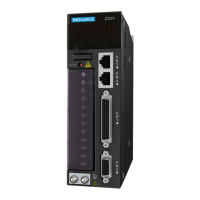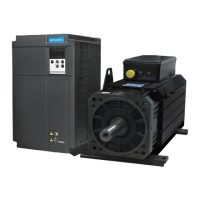Chapter 4 Running and Commissioning IS620P User Manual
- 104 -
4.5.4 Notch
The mechanical system has a certain resonance frequency. If the gain is too high, resonance
around the resonance frequency may occur, and a notch can be used to solve the problem.
The notch reduces the gain of the specied frequency to suppress the mechanical resonance.
Therefore, the gain can be set higher than that without using the notch.
A total of four notches can be used, and each has three parameters, frequency, width level,
and attenuation level. When the frequency is the default value 4000 Hz, the notch is actually
invalid. The 1st and 2nd notches are manual notches, and their parameters need to set
manually. The 3rd and 4th notches are self-adaptive notches, and their parameters are set
automatically by the servo drive; if the self-adaptive mode is disabled, you can also set these
two notches manually.
The mode of the self-adaptive notch is determined in H09-02. When H09-02 = 1, only the 3rd
notch is valid; when the servo is enabled and detects resonance, the parameters of the 3rd
notch are set automatically to suppress the resonance. When H09-02 = 2, both 3rd and 4th
notches are valid, and their parameters can be set automatically.
The self-adaptive notch is preferred during the use. If the self-adaptive notch cannot produce
satisfactory performance, use the manual notch. When using the manual notch, set the
frequency to the actual resonance frequency, which is obtained by the mechanical feature
analysis tool of the background software. Use the default value 2 of the width level. Adjust the
depth level based on the actual conditions. The smaller the value is, the better the resonance
suppression result is. The larger the value is, the worse the resonance suppression result is.
If the depth level is set to 99, the resonance suppression almost does not work. Reducing the
depth level enhances the suppression result, but causes phase lag and system instability. Do
not reduce the depth level if not necessary.
More precautions about the notch are as follows:
•
The notch can be used in only the speed control and position control modes.
•
When H09-02 is always 1 or 2, the updated parameters of the self-adaptive notch are
automatically written to EEPROM every 30 minutes, and the update within 30 minutes is
not written to EEPROM.
•
When H09-02 is set to 0, the current parameters of the self-adaptive notch will keep
unchanged. After the self-adaptive notch is used for suppression and the system becomes
stable for a certain period, you can set H09-02 to 0 to x the parameters of the self-
adaptive notch.
•
It is recommended that at most two notches work at the same time. Otherwise, the
resonance may become severe.
•
When the resonance frequency is below 300 Hz, the suppression effect of the self-
adaptive notch may degrade.
•
When the resonance cannot be cleared after a long time use of the self-adaptive notch,
disable the servo drive.

